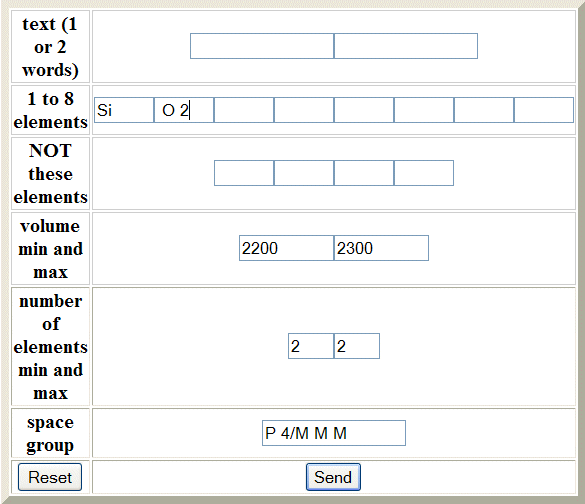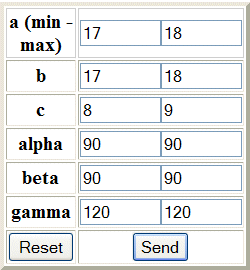The PCOD offers 2 powerful options for a search :
1- By combining in the way you choose : text (1 or 2 words or parts of words), elements (1 to 8, with formula numbers or not), excluded elements (1 to 4), volume (min and max), number of elements (min and max) and space group :

There is no obligation for filling all boxes, select those corresponding to your needs (see below more details).
2- By exploring ranges of cell parameters

- - Text search - contrarily to the COD, there are not a
lot of informations to be obtained here since the sources of the data are
mainly from 2 computer programs (ZEFSA and GRINSP which you can select
as words in the search). However, you may type some zeolite names (LTA,
MTN, SOD, etc, but they are few) and also the probable space groups are
searchable there (P b n m, I 41/a m d, P 63/m m c, etc, etc, Hermann-Mauguin
with spaces between symmetry elements).

You may also directly ask the database by sending requests like : http://sdpd.univ-lemans.fr/cod/pcod/result.php3?text1=LTA.
- Selecting elements (up to 8), allows for an inclusive search
(compounds with other elements are not excluded).
NOTE : Apply the following
rules : Typing Ba and N may return compounds containing Ba and Ni, In,
Sn, Zn ! For one-letter elements like N (O, P, S, V, etc), type a space
before the element and also after it and the search should work better.

It is also possible to search by formula in a special way : an element should be followed by a space (and preceeded also by a space if that element has only one letter) and then the number of elements : Zr 3. Obtaining Zr3Si2O13 will be done also by using three boxes, one with Zr 3, the second with Si 2 and the third with O 13 (one space between the element and the number) :

- NOT these element. Allows for exclusion if needed.
- Volume range between Vmin and Vmax. If you dispose of that information, then you believe that your powder pattern was indexed successfully.
- Number of elements. min and max. You may set min=max=n in order to limit the search to compounds containing only n different elements.
- Space group. The space groups in which the structure are described into the CIF are searchable there (P b n m, I 41/a m d, P 63/m m c, etc, etc, Hermann-Mauguin with spaces between symmetry elements, capital letters or not). Note that all the GRINSP data have a description in the P 1 space group, but their probable space group can be different and is searchable at the text option above.
About CIFs : see the IUCr Web page. New CIF software : EnCIFer by CCDC.
The CIF filenames in the PCOD :
- from 8000000.cif to 8999999.cif : files from the ZEFSA-II computer
program.
- N******.cif with N different of 8 : files from the GRINSP computer
program.
Best wishes !
Send bug reports and wishes to pcod@cristal.org.
or
Search the database

Updated 21/01/2009